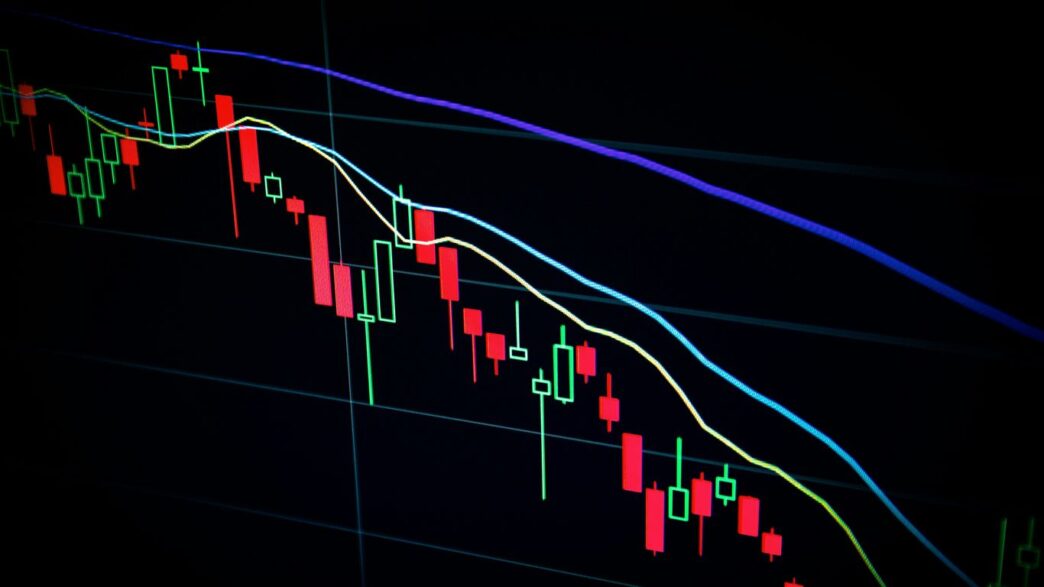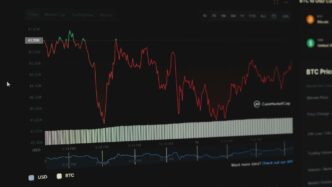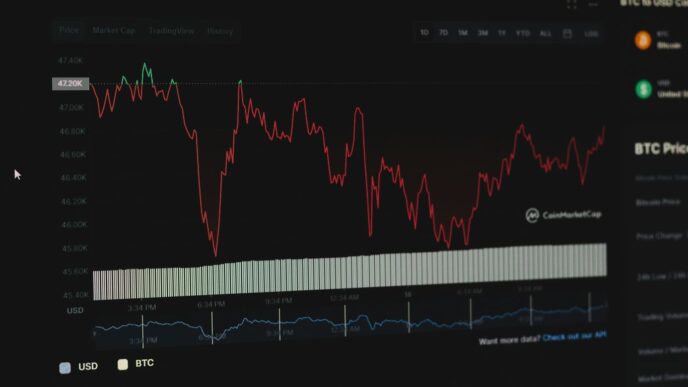This past weekend, the crypto market took a serious hit. Billions in value seemed to vanish overnight, leaving many investors wondering what exactly is going on. It felt like a sudden plunge, with major coins like Bitcoin and Ethereum seeing big drops, and even smaller altcoins getting hammered. So, what’s behind this sharp downturn? We’ll break down the reasons, look at the impact, and see what experts think about the current situation and what might happen next. This event really highlights how quickly things can change in the digital asset space.
Key Takeaways
- Geopolitical tensions, specifically U.S.-China trade disputes and tariff announcements, acted as a major trigger for the recent crypto sell-off, creating broad market uncertainty.
- Market mechanics like overleveraging, forced liquidations, and the influence of spot crypto ETFs and institutional players amplified price swings and contributed to the rapid decline.
- The weekend crash saw billions wiped out from the total crypto market capitalization, with Bitcoin, Ethereum, and numerous altcoins experiencing significant, sharp drops in value.
- Despite the short-term volatility, some experts believe crypto’s underlying fundamentals remain solid, suggesting the crash might be a temporary correction rather than a systemic failure.
- The human impact of these crashes can be severe, causing financial and emotional strain for investors, underscoring the importance of risk management and seeking guidance.
Geopolitical Tensions Spark Crypto Sell-Off
This past weekend, the crypto market took a serious hit, and a lot of it seems tied to what’s happening on the global stage. When big news breaks about international relations, especially involving major economies like the US and China, it can really shake things up for all sorts of investments, including digital assets. It’s like a ripple effect; trouble in one area can quickly spread. The sudden escalation of trade tensions between the United States and China appears to be a primary driver behind the recent sell-off.
US-China Trade War Escalation Triggers Market Panic
Things got dicey after reports surfaced about new, significant tariffs being considered. Specifically, a proposed 100% tariff on certain Chinese tech exports sent shockwaves through the markets. Because crypto is still seen by many as a riskier asset, and because it’s open 24/7, it was one of the first places investors reacted. This news created a wave of uncertainty, making people nervous about the broader economic outlook. When investors get nervous, they tend to pull their money out of assets they perceive as more volatile, and that’s exactly what happened here. This kind of event highlights how interconnected global finance has become, and how geopolitical events can impact even the newest markets like cryptocurrency.
Tariff Announcements Create Macroeconomic Uncertainty
These tariff announcements don’t just affect the companies directly involved. They create a cloud of macroeconomic uncertainty. When supply chains might get disrupted or when the cost of goods could go up, it makes it harder for businesses to plan and for consumers to spend. This general unease can lead investors to move their money into safer havens, or at least away from assets that are known for big price swings. The crypto market, being relatively young and still finding its footing, can be particularly sensitive to these kinds of broad economic worries. It’s not just about the tech itself, but how it fits into the bigger economic picture.
Global Supply Chains and Tech Growth Concerns
Beyond the immediate financial markets, there are deeper concerns about what these trade disputes mean for global supply chains and the future of technology growth. Many cryptocurrencies and related technologies are part of the broader tech sector. If trade wars slow down innovation or make it harder for companies to operate globally, it can cast a shadow over the long-term prospects of these digital assets. Investors start to question the future growth potential, and that can lead to a rush for the exits. It’s a complex web, and when one thread gets pulled, the whole thing can start to unravel, at least temporarily.
Market Mechanics Amplifying Price Swings
It wasn’t just big news events causing the crypto market to wobble this past weekend. Some of the wilder price swings we saw can be chalked up to how the market itself works, especially when things get a bit shaky. Think of it like a crowded room – when one person starts to panic, it can quickly spread.
Overleveraging and Forced Liquidations
One of the big players in these sharp drops is something called overleveraging. Basically, traders borrow money to make bigger bets on crypto prices. This can work great when prices are going up, but when they start to fall, those borrowed positions can get wiped out in an instant. This forces traders to sell their assets to cover their debts, which pushes prices down even further. It’s a bit of a domino effect. We saw some of this happen, but data suggests it wasn’t the main driver this time. A lot of the selling seemed more controlled, like traders deciding to pull back rather than being forced out by debt. Still, it’s a factor that can make any downturn feel much worse.
Impact of Spot Crypto ETFs and Institutional Players
The arrival of spot crypto ETFs has brought more big money into the crypto space. While this is generally seen as a good thing for long-term growth, it also means that when these large players decide to move, their actions can have a significant impact. On Monday, for instance, US Bitcoin and Ethereum spot ETFs saw considerable outflows. This means institutions were selling, not buying. When big players sell, it can put downward pressure on prices, especially if the market isn’t deep enough to absorb all those sell orders easily. It’s a new dynamic we’re still getting used to.
Market Thinness and Rapid Selling Dynamics
Sometimes, the crypto market can feel a bit like a small pond. When a lot of selling happens all at once, especially if there aren’t many buyers ready to step in, prices can drop very quickly. This is what happens in a ‘thin’ market. We saw reports that when certain news broke, market depth – which is basically how many buy and sell orders are sitting there waiting – dropped dramatically. This lack of readily available buyers meant that even moderate selling could cause big price drops. Automated trading programs can also speed this up, reacting to price changes and adding to the selling pressure before human traders can even react. It’s a reminder that while crypto is growing, its mechanics can still lead to some pretty wild rides. Understanding these market influences is key for anyone trying to make sense of the daily price action.
Assessing the Scale of Weekend Losses
This past weekend was a rough one for crypto investors, no doubt about it. We saw a pretty significant drop across the board, wiping out billions in value in a very short time. It felt like everything was going down all at once, and for a while there, it was hard to see any green on the charts.
Billions Wiped Out in Crypto Market Capitalization
The total value of the cryptocurrency market took a serious hit. We’re talking about billions of dollars just vanishing from the overall market cap in a matter of hours. It’s a stark reminder of how quickly things can change in this space. One minute things are looking up, and the next, a huge chunk of value is gone. This kind of rapid decline really shakes confidence, even for people who have been in the crypto game for a while.
Bitcoin and Ethereum’s Sharp Declines
Even the big players weren’t spared. Bitcoin, which had been hovering around $123,000, saw a sharp fall, dipping below $105,000 at its lowest point during the weekend’s turmoil. That’s a pretty big move for the market leader. Ethereum, the second-largest cryptocurrency, also experienced a significant drop, falling about 11% and briefly trading below $3,900 before a slight recovery. These major cryptocurrencies often lead the market, so their sharp declines signaled a broader issue.
Altcoins Experience Significant Plunges
If you thought Bitcoin and Ethereum had it bad, many smaller altcoins got hit even harder. Some of these digital assets, especially those in the Web3 and DeFi sectors, saw their prices plummet by as much as 30% or even 40% in some cases, and this happened incredibly fast, sometimes within minutes. Coins like Solana and Cardano experienced drops of up to 30%. Others, such as Talos, B1OAI, and Pepecoin, also saw losses ranging from 10% to nearly 30% in just a 24-hour period. This kind of extreme volatility for smaller coins often leads to widespread liquidations, making the losses even more painful for holders. It really highlights the increased risk associated with these less established digital assets, especially during periods of market panic. For those holding these types of assets, it was a particularly brutal weekend, and many are likely still assessing the damage and considering their next steps in the crypto markets.
Expert Analysis: A Temporary Correction?
So, was this weekend’s big crypto drop the start of something worse, or just a quick stumble? Most folks I’ve heard from seem to think it’s more of a temporary hiccup. The underlying tech and how people are getting into crypto haven’t really changed, which is a good sign. It feels like the market just got a bit overexcited and then pulled back.
Fundamentals Remain Solid Despite Volatility
Even with billions wiped out in a flash, the core ideas behind crypto are still strong. Think about it: the technology itself, like the blockchains, kept running pretty smoothly even when things got crazy on some of the trading platforms. Big players like custodians and those who provide liquidity didn’t seem to get shaken out. It’s more like individual traders who were taking big risks got caught. The tech is proving it can handle stress, which is a big deal.
Market Stability and Technology Resilience
When the markets started to tank, decentralized exchanges like Uniswap and Aave kept chugging along. That’s pretty impressive, showing that the decentralized nature of some crypto systems can actually be a strength when things get shaky. While some centralized exchanges had issues, the decentralized ones held up better than expected. It’s like the engine kept running even if the dashboard flickered.
Investor Behavior and Risk Management
It seems like a lot of the panic selling came from people who had borrowed money to trade crypto, known as overleveraging. When prices dropped, they were forced to sell, which just pushed prices down further. This kind of thing can really amplify the swings. It’s a good reminder that while crypto can be exciting, taking on too much risk, especially borrowed money, can lead to some rough times. Managing how much risk you’re comfortable with is key, and maybe not checking your portfolio every five minutes during a dip helps too.
The Human Impact of Crypto Crashes
When the crypto market takes a nosedive, it’s not just numbers on a screen that are affected. For a lot of people, these digital assets represent hard-earned money, savings, and even their livelihoods. The recent sharp drop, which saw billions wiped out in a matter of hours, has undoubtedly left many feeling the sting.
Emotional and Financial Strain on Investors
It’s easy to forget the human element when we talk about market caps and trading volumes. But behind those figures are real people. Imagine checking your portfolio and seeing a significant chunk of your savings vanish. That kind of shock can lead to a lot of stress, anxiety, and sleepless nights. For some, especially those who might have invested more than they could afford to lose, the financial strain can be immense. It’s a tough pill to swallow when you thought you were making smart moves, only to see your investments plummet.
Consequences for Traders and Large Holdings
Traders who were heavily leveraged, meaning they borrowed money to increase their potential gains, often face the worst outcomes. When prices drop suddenly, these positions can be liquidated automatically, wiping out their entire investment and sometimes even leaving them in debt. We’ve heard stories of individuals who managed substantial portfolios, perhaps for clients or even a community fund, and had to deal with the fallout of massive losses. This isn’t just about personal wealth; it can impact professional reputations and trust.
The Importance of Perspective and Guidance
It’s a tough lesson, but one that many in the crypto space learn the hard way: volatility is part of the game. While the losses can feel devastating in the moment, maintaining perspective is key. This weekend’s sharp decline, while painful, is being viewed by some experts as a temporary correction rather than a fundamental breakdown of the technology.
Here are a few things to keep in mind:
- Understand Your Risk Tolerance: Before investing, really think about how much you can afford to lose without it wrecking your life. Crypto is high-risk.
- Diversify Your Investments: Don’t put all your eggs in one basket. Spreading your money across different assets can cushion the blow if one particular investment tanks.
- Seek Reliable Information: When things get crazy, it’s easy to panic. Stick to reputable news sources and consider talking to a financial advisor who understands the crypto market.
Ultimately, crypto crashes highlight that these markets are still maturing. While the technology itself might be resilient, the human and financial impacts of these rapid price swings are very real. It underscores the need for careful planning and emotional control when dealing with such unpredictable assets.
Navigating Short-Term Volatility
So, the crypto market took a bit of a tumble this past weekend. It’s enough to make anyone a little uneasy, right? But before we all start hitting the panic button, let’s look at what might be happening and what it could mean.
Signs of Market Recovery and Lingering Risks
It’s not all doom and gloom, though. Some data suggests the market might be finding its footing. For instance, while there were big drops, some analysts point out that the decline in futures open interest wasn’t entirely forced liquidations. This could mean a more controlled deleveraging rather than a full-blown panic. We saw Bitcoin and Ethereum recover somewhat, which is a good sign. However, lingering risks are definitely still out there. Things like geopolitical news, especially around trade wars, can still shake things up quickly. Plus, those outflows from spot crypto ETFs on Monday show that institutional players are still a bit hesitant. It’s a mixed bag, really.
Anticipating Future Price Swings
What does this mean for what happens next? Well, expect more ups and downs. When market makers pull back after a big move, liquidity can get thin. This means even smaller trades could cause bigger price changes. Think of it like a small ripple causing big waves in a shallow pond. It’s probably wise to brace for more short-term jitters. The crypto market is still growing up, and it’s going to have these moments. It’s important to have a plan for dealing with these swings, maybe by looking at strategies for crypto volatility.
The Role of Monetary Policy and Trade Dynamics
Don’t forget the bigger picture. Stuff happening in the global economy really does affect crypto. For example, the US Federal Reserve’s stance on interest rates can make a difference. If they signal they’re going to be more relaxed with rates, that can sometimes be good for riskier assets like crypto. On the flip side, trade tensions, like the ones we’ve seen between the US and China, create a lot of uncertainty. This uncertainty makes investors nervous, and they might pull money out of things they see as risky, like crypto. So, keeping an eye on these big economic and political moves is pretty important for understanding where crypto prices might go.
So, What’s the Takeaway from This Wild Ride?
Well, this past weekend really showed us that the crypto market is still a bit of a rollercoaster. One minute things are looking up, and the next, bam! Prices are dropping fast, wiping out billions. We saw major coins like Bitcoin and Ethereum take a hit, and smaller ones got hammered even harder. Experts are pointing to big global stuff, like trade tensions between the US and China, as a major reason for the panic. Plus, how people trade, especially with borrowed money, can make things much worse, much faster. Even though things started to bounce back, it’s a clear sign that this market is super unpredictable. It’s a good reminder for everyone involved to keep a close eye on world news, be careful with how much risk you’re taking on, and always be ready for sudden, big moves. This crash proves that even the biggest digital coins aren’t immune to wild swings.
Frequently Asked Questions
What caused the crypto market to drop so suddenly?
The big drop happened because of worries about trade between the U.S. and China. When the U.S. announced big new taxes (tariffs) on some Chinese products, it made investors nervous about the economy. This fear spread to crypto, causing many people to sell their digital coins quickly.
How much money was lost in the crypto crash?
During the recent sell-off, the total value of the crypto market dropped by over $19 billion in just one day. Many investors saw the value of their digital money disappear very fast.
Which cryptocurrencies were hit the hardest?
Bitcoin and Ethereum, the two biggest cryptocurrencies, saw significant price drops. However, many smaller coins, known as altcoins, like Solana and Cardano, fell even more, some losing up to 30% or more of their value.
Are these kinds of crashes common in the crypto world?
Yes, the crypto market is known for being very unpredictable and can have big price swings, or ‘crashes.’ This is partly because it’s a newer market and can be easily influenced by news and investor emotions. Even though prices can go up a lot, they can also come down very quickly.
Is the crypto market recovering, or is it still risky?
After the sharp fall, some cryptocurrencies started to bounce back, showing signs of recovery. However, experts warn that the market can still be very jumpy. It’s important for investors to be careful because more ups and downs are likely.
What should investors do when crypto prices crash?
When prices crash, it can be scary. Experts say it’s important not to panic. They advise investors to understand the risks, not invest more than they can afford to lose, and to have a plan for managing their investments. Sometimes, taking a step back and getting advice can help.














